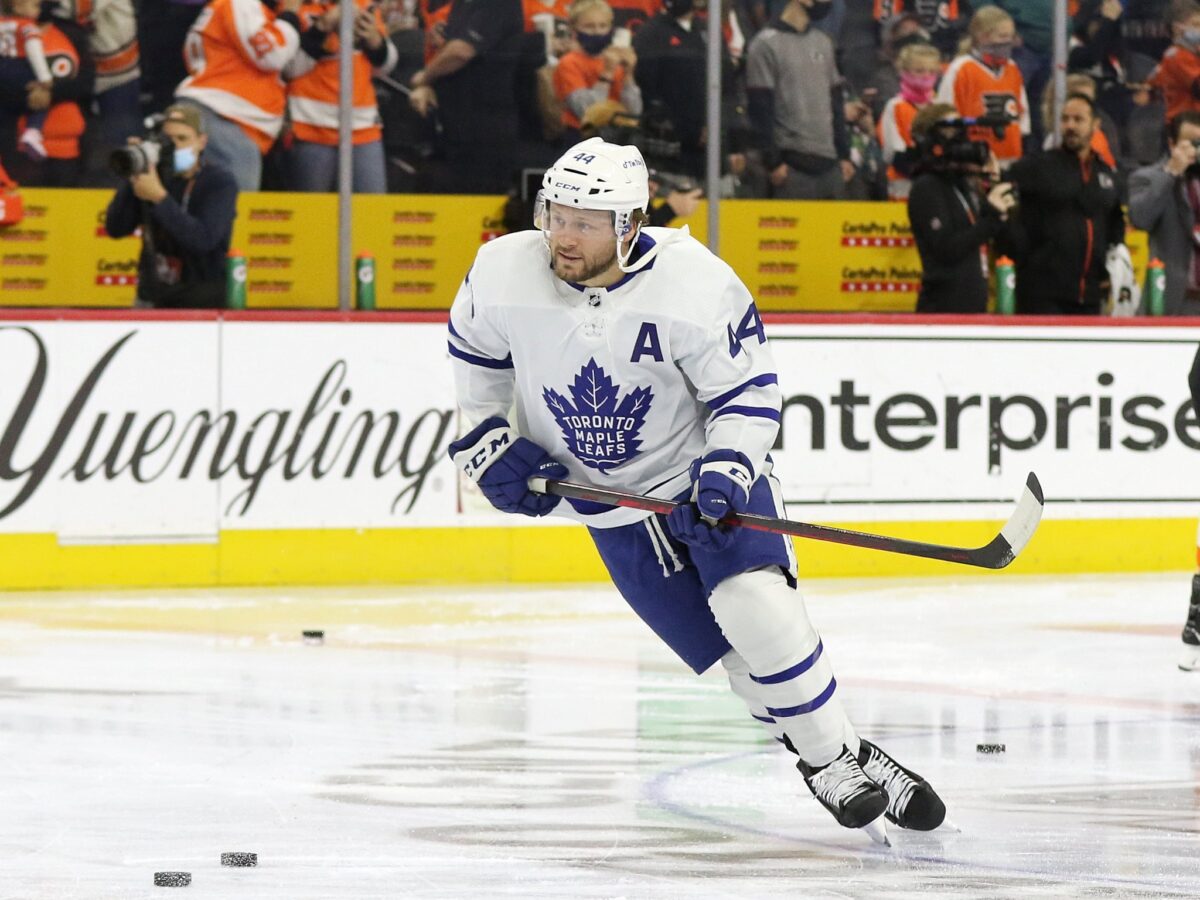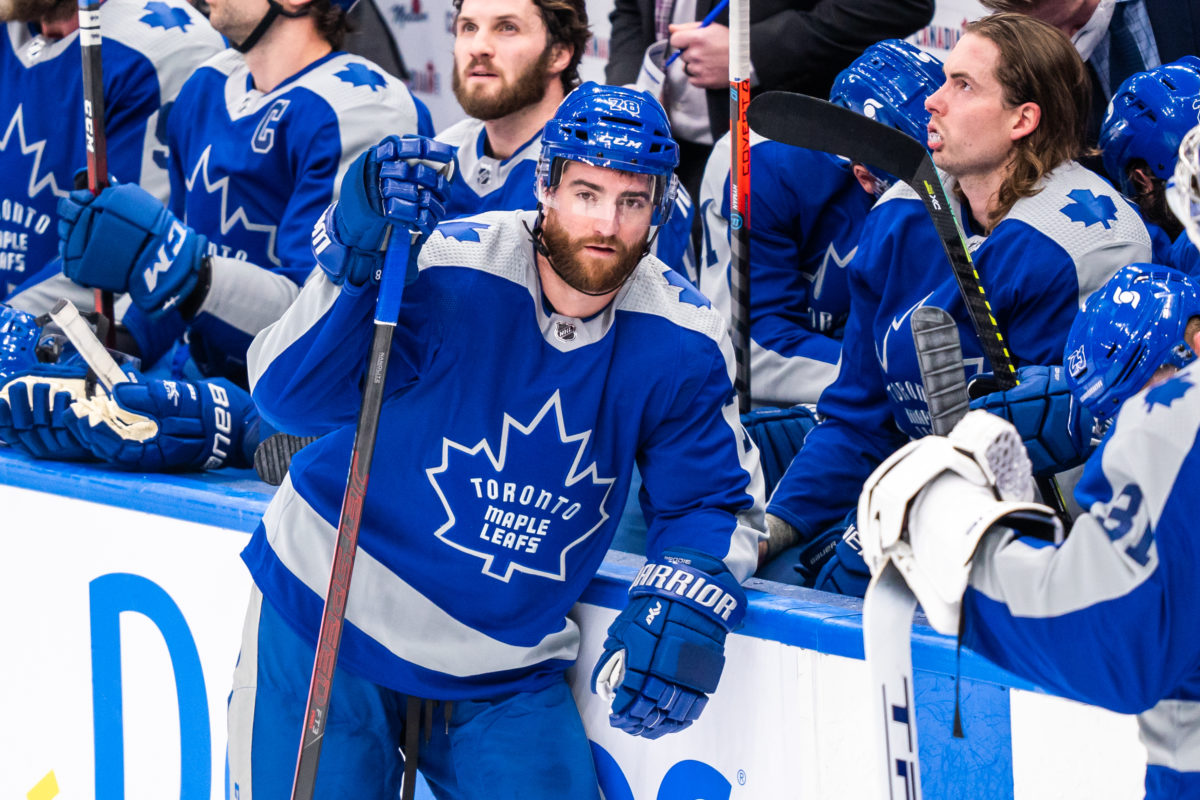We all have opinions on how each defenseman performed for the Toronto Maple Leafs this past season. Everyone’s opinion varies to a certain degree. Take Morgan Rielly as an example. Some fans feel he is a Norris-worthy player. Others think his defensive play is so lacking that he shouldn’t even be on the team.
Related: Maple Leafs News & Rumors: Kadri, Sandin & Liljegren Offer Sheets
What do the numbers say? If we examine each player’s performance for the regular season by using on-ice, five-on-five, per-60 minutes played statistics, how does each defenseman rank amongst his teammates?
What Advanced Analytics Show About Players
Why use on-ice numbers instead of actual individual stats, and why five-on-five numbers? Hockey is a team sport. How the team performs is influenced in some way or another by every player who is on the ice.
Even a goalie has an influence on any goal scored by his teammates. A player’s confidence, or lack of it, that their goalie can stop the puck if he takes a chance and joins a rush can influence how that player plays.

Think back to the season Morgan Rielly scored his 72 points paired with Ron Hainsey. Rielly knew Hainsey had his back: that allowed him to play more offensively. While Hainsey didn’t score the points, he played an important role in Rielly scoring them.
The reason we are looking exclusively at five-on-five numbers is that the majority of the game is played five-on-five. Last, because of the discrepancy in ice time, we will break the numbers down per 60 minutes played to even the playing field.
The Six Offensive Categories Used to Rank Maple Leafs Defenseman
In this post, we will be looking at the numbers tracked by naturalstattrick.com in six categories to study the offensive effect each defenseman had on the play when they were on the ice. Those categories will be Shot-Attempts For (Corsi For), Shots For, Scoring-Chances For, High-Danger Chances For, Goals For, and Expected-Goals For.
Related: Maple Leafs Have Best Defense Corps Among Canadian Teams
We want to note that a drawback of using these numbers is that using numbers only does not take into consideration the quality of the teammates are on the ice with a given player, or the quality of the opposition that player is playing against. The rankings are more of a look at how a player did in the assignment given to him by the coach. Just because a third-pairing defenseman ranks higher than a first-pairing defenseman doesn’t mean he is a better player, just that he might have done a better job at the role he was given.
We also want to note that we do not feel these numbers are in any way the exclusive way to rank players. Analytics is but one tool of many that coaches and teams might use to rate a player’s performance.

One last note, we are going to use 299 minutes as a minimum of ice time for the players in the ranking. The reason is to include Mark Giordano’s play in the study. Giordano played 299:36 for the Maple Leafs in the regular season.
What Do the Numbers Tell Us About the Team’s Defense Last Season?
With that in mind, let’s look at the numbers.
Shot-Attempts For per 60
1: Rasmus Sandin 64.0
2: Timothy Liljegren 63.0
3: Morgan Rielly 62.5
4: Jake Muzzin 61.0
5: Travis Dermott 60.0
6: Mark Giordano 59.9
7: Justin Holl 59.2
8: T.J. Brodie 58.4
8: Ilya Lyubushkin 58.4
Shots For per 60
1: Rielly 35.0
2: Sandin 34.6
3: Liljegren 34.4
4: Brodie 32.8
5: Dermott 32.7
6: Giordano 32.6
7: Holl 32.2
8: Muzzin 32.0
9: Lyubushkin 31.1
Scoring-Chances For per 60
1: Sandin 34.9
2: Liljegren 34.5
3: Muzzin 34.4
4: Holl 34.0
5: Rielly 33.9
6: Giordano 33.2
7: Dermott 32.2
8: Brodie 31.4
9: Lyubushkin 30.6
High-Danger Chances For per 60
1: Liljegren 14.7
2: Sandin 14.0
3: Holl 13.7
4: Muzzin 12.9
4: Lyubushkin 12.9
6: Giordano 12.8
7: Rielly 12.7
8: Brodie 12.2
9: Dermott 12.1
Goals For per 60
1: Giordano 4.01
2: Liljegren 3.83
3: Rielly 3.66
4: Brodie 2.85
5: Sandin 2.98
6: Holl 2.93
7: Muzzin 2.62
8: Dermott 2.59
9: Lyubushkin 2.55
Expected-Goals For per 60
1: Liljegren 3.14
2: Sandin 3.09
3: Giordano 2.92
4: Holl 2.86
5: Rielly 2.85
6: Dermott 2.79
7: Muzzin 2.76
8: Brodie 2.68
9: Lyubushkin 2.50
A Summary of the Findings
Looking at the average ranking in each of the six offensive categories, the following ranks emerge.
First, Liljegren 1.8
Second, Sandin 2.2
Third, Rielly 4.0
Fourth, Giordano 4.5
Fifth, Holl 5.2
Sixth, Muzzin 5.5
Seventh (tie), Brodie 6.7
Seventh (tie), Dermott 6.7
Eighth, Lyubushkin 8.0
Observations
The two youngest defensemen, Liljegren (23) and Sandin (22) posted the best overall ranking for the six offensive categories. This does not mean they were the best offensive defensemen on the team. They both played predominantly sheltered third-pairing roles against weaker opposition.
Related: Ranking Every Calder Trophy Winner Since 2005
On the flip side, they would not have played a lot with the Maple Leafs’ top-six forwards. The offensive numbers they put up would have been playing behind bottom-six players. These are also just offensive statistics and do not take into account defensive play.
What these numbers do say is that both Liljegren and Sandin were good at generating offense at or near the bottom of the lineup. That’s still a good thing. It also means that they may be capable of taking on more responsibility and possibly play higher in the lineup.

We also see that Rielly, who is regarded as and paid as the best offensive defenseman on the team, was the third highest-ranking offensive player on the team. In his case, that offense would have been created playing against the opposition’s top players.
Giordano’s also ranked highly in regard to offense. Note that he did very well in Goals For and Expected-Goals For.
Holl and Muzzin, despite their struggles this season were both middle of the pack for offense. We will have to see how they did defensively.
Related: 2022 NHL Draft Guide
Brodie, the now-departed Dermott, and Lyubushkin finished in the bottom three for creating offense. Lyubushkin’s average ranking of eighth matches the eye test. He’s not noted for his offensive play and his underlying numbers back that up.
Lyubushkin played up and down the lineup with the Maple Leafs. His offensive numbers indicate that he may be best suited for a role more towards the bottom of the lineup. We will have to see how he ranks defensively.
It also makes sense that Brodie did not rank highly in offense. His job is to take care of the defensive duties allowing those around him to concentrate more on offense.

Dermott has never put up good offensive numbers, which is probably one reason he was surpassed by the other players and eventually traded away. He has in the past always put up good defensive numbers. We will have to see how he made out defensively.
So there you have it. This is how the nine defensemen that played the most minutes fared, and ranked, for offensive play. In an upcoming article, we’ll look at defensive numbers.
[Note: I want to thank long-time Maple Leafs’ fan Stan Smith for collaborating with me on this post. Stan’s Facebook profile can be found here.]
You may also like:
- Maple Leafs Should Keep Murray as Third Goaltender
- Flames & Maple Leafs Trade History Revisited
- 3 Players the Maple Leafs Could Target on a PTO
- NHL Rumors: Oilers, Maple Leafs, Capitals, Kuznetsov News
- Maple Leafs Should Target Evgeny Kuznetsov as Reclamation Project